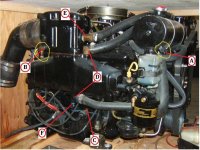Akjohn
Contributing Member
I need some advice to make sure this motor is drained before I stick it outside at -35F, the block had coolant in, good to -19F, I drained it from both sides of the block. But am concerned about the raw water side of things, as visible in the photos I have not removed the motor from the crate, hoping to leave it in the crate and store it outside until I am ready to put it in the boat.
I bought the motor second hand and am not very familar with it......, I have removed the plugs at each manifold and also the plug in the heat exchanger. Circled in the pics.

Nothing came out at either spot.....? Can I assume the raw water side is sufficently drained down, to not worry about water still setting in a low spot somwhere and freezing? I blew air through the raw water intake side of the heat exchanger and could feel some air coming out the elbows, but it was dry....
Thanks.......
I bought the motor second hand and am not very familar with it......, I have removed the plugs at each manifold and also the plug in the heat exchanger. Circled in the pics.

Nothing came out at either spot.....? Can I assume the raw water side is sufficently drained down, to not worry about water still setting in a low spot somwhere and freezing? I blew air through the raw water intake side of the heat exchanger and could feel some air coming out the elbows, but it was dry....
Thanks.......







